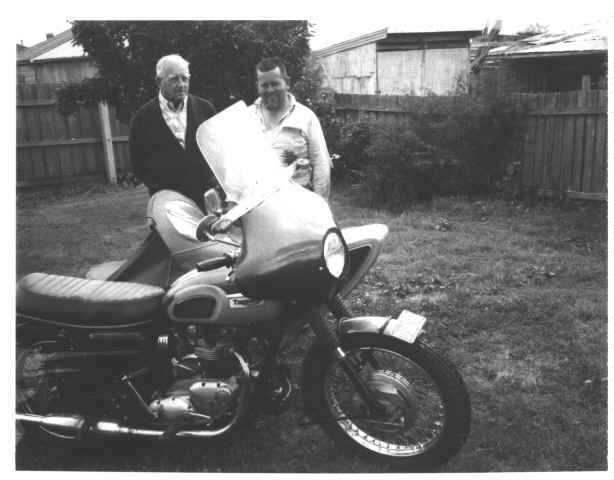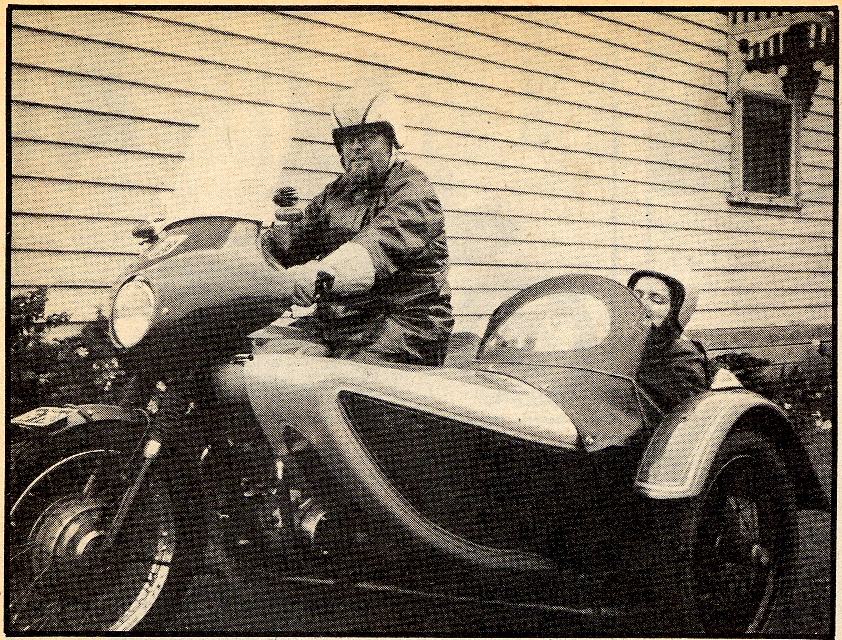Further to yesterday’s post, and just to backtrack a little, I need to mention the history of that six-passenger chair. It was only fitted to the Triumph for a little more than a week, or certainly less than a fortnight. It was removed from the Dusting chassis the same afternoon that we had gotten rid of the queen sized bed.

A fortnight earlier, I had happened on an advertisement in a newspaper which read in part: “Double Adult sidecar for sale; seldom used. . .” I rang the number and got the address and set a date and time to go and inspect it. The advertiser warned me that it was big and heavy: he had built it with a double purpose: it was to be a camper that he could sleep in and also that he could carry two very large mates in. He warned me that the sidecar was very long, since he had designed it to give plenty of legroom to men who were both 2 metres (6 foot 7 inches) tall. We agreed on a price and I rode my triumph outfit there with the Dusting sidecar body already removed and with just a few tools in a backpack ockie-strapped to the sidecar chassis.
It was long after dark and already bitterly cold when I arrived at the address in Glenroy.
We went out behind his shed and he lifted the tarpaulin off an enormous red construction of wood and seaply. The body was well over a metre (3 foot 4 inch) wide and probably over three metres (ten feet) long. The front was semicircular and raked back to give it some sort of ability to cut through the air. In the dark, I could see that seats were fitted, but couldn’t really see what they were made of. While it was even larger than it had seemed over the phone, I decided that for the price, it had possibilities, so I handed over the cash.
We used four coach bolts to fasten the body to my chassis working by torchlight.
I rode back to Morwell noticing that, despite the lower sidecar gearing of the bike, I had to keep changing back through the gears for every hill. Every time I opened the throttle, the outfit would lurch to the left; every time I shut the throttle or braked, the outfit would try to swerve to the right. It was a long, slow ride home under the frosty light from a full moon. Long after midnight I turned it into our driveway, parked on the front lawn, and quietly snuck in the back door and went to bed.
In the morning light I went outside to see what I had bought.
The backboard of the front seat was removable and had padded foam-filled upholstery glued to its front side. The front seat itself was very wide and very long and might quite possibly have originally come from a bus or some other form of public transport. It was so wide that we soon ascertained that two of my siblings could easily sit side-by-side on it. The rear seat, way down there at the back, was the same width, but the seat cushion was much shorter. It was fixed to the floor and the backrest was permanently fitted to the rear of the bodywork. It was my brother who first realised that the front seat could be slid backwards and, if only slid partway and the backboard was re-inserted on top of it, could be used to provide short seats facing both ways. A quick gluing of cloth-covered, foam-filled, cushioning material to the rear of the front seat backboard ensured comfort for any passengers who might be seated facing backwards in the rear compartment.
Our intention at first was to ride around town with three of my brothers in the sidecar. Mick stuck his head in the front door and yelled, “Who wants to go for a test ride in Phil’s new sidecar?”
The entire family came trooping out (I have eight siblings), and started getting into the chair which had been set up with the front backboard dividing the front seat in two. In a few moments there were six young Smiths seated in the chair. I kick started the bike and mounted the pilot’s seat. My sister Karen said, “Hey, wait for me!” as she climbed on the pillion seat. So there we were: six in the sidecar and two on the bike.
I clicked it into gear and tried to let the clutch out. My Dad started pushing on the back of the sidecar while my Mum pushed the luggage rack on the back of the bike. The smell from the burning clutch was pretty severe, but we were soon rolling! We drove up to the main street and did a couple of laps of town: Commercial Road, over the railway, High Street, over the railway, and around again. We coasted in to the parking lot near the railway station (universally known to the town’s young hoons as “Drag Square”) where there was a good slope down for us to get started again, and switched off.
Two carloads of police arrived, piled out of their cars and surrounded our outfit. They looked at how everyone was seated and that the seats fulfilled all legal requirements, and agreed that it was roadworthy and legal. “But I bet the clutch of your Trumpy is burned out within a week,” said the Senior Constable. “Now let’s see how she goes!”
I kick started the Trumpy and several of the police officers helped with a push as I let out the clutch. We did one more complete lap of town, waving cheerily to the police who were still in the parking lot, and then headed home.
The following morning I rode the outfit to the school where I was then the Headmaster, Dumbalk North Primary School. I cannot remember now whether I took any kids for a ride, but I do remember that the exceptionally heavy sidecar was a real handful on the steep hills of South Gippsland.
The following weekend, we used it to dispose of the unwanted queen-sized bed and then lifted the body off the chassis. We could almost hear that Triumph heaving a great sigh of relief!

A week later, we observed another ad in the paper: “Wanted: large double-adult sidecar body to fit Dusting chassis on Indian motorcycle . . .” and I was able to sell it for the same price I had paid for it only a fortnight earlier!